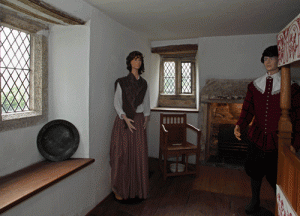Stuart House, History

Kings Room – Stuart House
Origins
Who built the original house and when is a mystery. The granite arches and other features give a date around 1500 but there is no documentary evidence further back than the early 17th century. The house had four large windows facing east over the town towards the church and castle. At the beginning of the 16th century there were two large institutions which could have funded the building of such a substantial house, the Duchy of Cornwall and the Priory at Launceston, both of which had substantial interests in the town. It is possible, but probably unlikely, that a wealthy individual built it.
The 17th to 19th centuries
By 1627 the house was owned by the Jane family. This family had been in the area since the 15th century. Thomas Jane was at one time Mayor and Steward in the town and his son, Joseph, was sometime Mayor, Chief Steward and MP for the town in the 1620s to 40s. They appear to have reversed the house from facing east over the town to west facing onto the Highway (Bar Street, Barrel Street, Barras Street and also Pricke Streert). They built the tower porch and the three storey, double gabled wing to the east and closed up the big windows in the east face.
Joseph supported King Charles in the Civil War and hosted him in the house in August 1644. He played a significant role in Cornwall during the years 1642-5 but then went into exile and forfeited his estates. He died in Holland in 1658. However, at the Restoration his wife and surviving children appear to have regained this house and it eventually passed through the hands of his daughter and became an important residence in the town, home to several leading citizens. It may have been subdivided as there are two strands of deeds which only unite in the early 19th century.
In one strand, a local carpenter refers to it in 1794 as ‘my new built house’ and we assume that it was he who put in the sash windows, built a double gabled, two storey wing to the south and altered the top floor on the north end, raising the roof there. He may also have added a single storey room to the east. He may also have covered both the front and the back of the house with slates.
At the end of the 19th century the house was owned by a doctor. At that time some of the windows on the ground floor were altered.
The 20th Century.
The house passed through the hands of several private owners until purchased by Stuart House Trust in 1988. By then the wing to the south and the room to the east had been demolished. It then underwent seven stages of renovation before it was fully opened as an Arts and Heritage Centre and community building in 2000.
Stuart House Trust.
This was set up in 1984/5 with the aims of purchasing, restoring and maintaining the house and using it as an Arts and Heritage Centre and community facility. It purchased the house in 1988 and applied for grants from a variety of bodies to carry through the long process of restoration. It re-roofed the house in 2008 and established a Civil War museum in 2009 and a recreated ‘birth’ room in 2013. This commemorated the birth of William Jane in the house in October 1645 at the height of the Civil War. Panels throughout the house give information on life in the house at that time.
A detailed history of the house is available to purchase from Reception.
